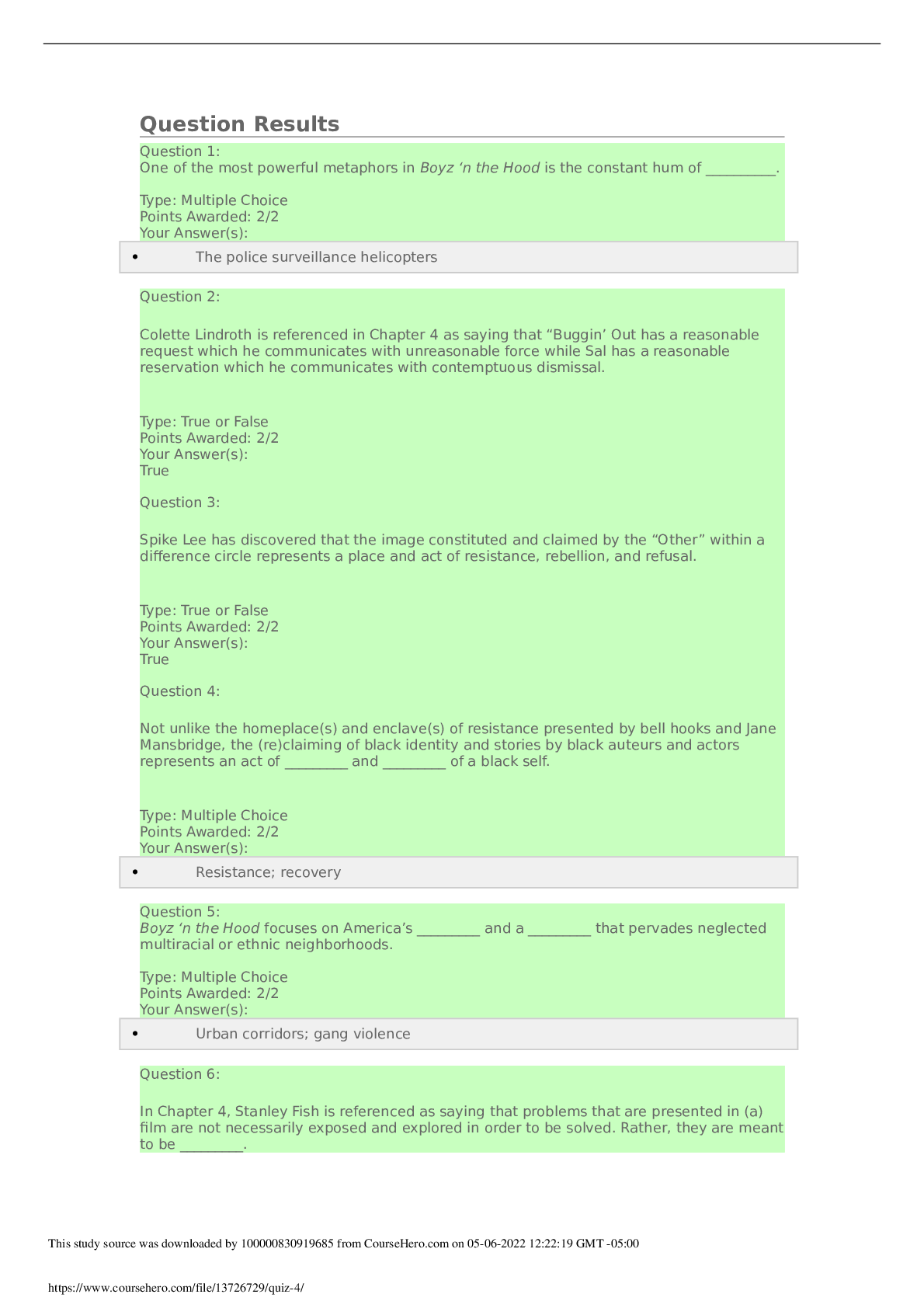Biology > Quiz > American Military University SCIN 130SCIN130 Quiz 4. All 31 QnA. 100% Correct (All)
American Military University SCIN 130SCIN130 Quiz 4. All 31 QnA. 100% Correct
Document Content and Description Below
Question 1 of 31 3.0 Points What is the major difference during cytokinesis in eukaryotes with or without a cell wall? A. cell plate in those without cell walls B. cleavage furrow in tho... se without cell walls C. cytokinesis does not occur in cells without a cell wall D. cytokinesis does not occur in cells with a cell wall Feedback: The cell wall means that cell division occurs with an additional structure, resulting from vesicles fusing on the cell wall. Review the cell cycle in Chapter 6. Question 2 of 31 3.0 Points During which stage in interphase does DNA synthesis occur? A. S phase B. G2 phase C. G1 phase D. Mitosis Feedback: Great job. Question 3 of 31 3.0 Points What is the phase that not all cells enter, but is a phase where cells are not actively dividing? A. G2 B. S C. G0 D. G1 Feedback: Some cells, either temporarily or permanently, are in a quiescent stage when they exit the cell cycle. Review the cell cycle in Chapter 6. Question 4 of 31 3.0 Points What is the purpose of overall purpose of mitosis? A. To produce daughter cells B. To accomplish cell division C. To accomplish nuclear division D. To produce gametes Feedback: The cell cycle is a continuous process in which the cell is prepping for division, replicating DNA and then the nucleus, finally dividing the cell. Review the cell cycle in Chapter 6. Question 5 of 313.0 Points What are oncogenes? A. normal cells that are visible on an X-ray B. genes that cause a cell to become cancerous C. cells that cause a mass without negative effects D. genes that are responsible for hair loss Feedback: Great job. Question 6 of 31 3.0 Points What is the purpose of checkpoints in the cell cycle? A. to keep any foreign DNA out of the cell B. to maintain protein health in the cell C. to ensure detrimental mutations are not passed on D. to make the division move faster Feedback: Great job. Part 2 of 8 - Chapter 7 18.0 Points Question 7 of 31 3.0 Points In which phase of meiosis does crossing over between homologous chromosomes occur? A. meiosis I B. cytokinesis C. interphase D. meiosis II Feedback: Great job. Question 8 of 31 3.0 Points In what phase of meiosis does Independent assortment of homologous chromosomes occur? A. interphase B. meiosis II C. meiosis I D. cytokinesis Feedback: Great job. Question 9 of 31 3.0 Points What is an individual with an incorrect number (2n-1 or 2n+1) of chromosomes called? A. aneuploid B. autosome C. polyploid D. euploid Feedback: Great job. Question 10 of 31 3.0 Points DNA synthesis occurs during: A. S phase of interphase of meiosis and mitosis B. S phase of interphase of mitosis only C. between meiosis I and meiosis II D. S phase of interphase of meiosis only Feedback: Great job. Question 11 of 31 3.0 Points What is NOT a benefit of asexual reproduction compared to sexual reproduction? A. all members of the population can reproduce themselves B. The offspring will be as successful in the habitat as the parent. C. The only source of variation in the next generation is mutation. D. They do not require another organism of the opposite sex.Feedback: Sexual reproduction is key to some species’ survival, as it increases the variability in a population. Review Chapter 7. Question 12 of 31 3.0 Points Meiosis produces daughter cells that are what? A. functionally different in different parts of the body B. used to replace dead or damaged cells in the body C. for growth of the body D. sexual reproduction Feedback: Great job. Part 3 of 8 - Chapter 8 18.0 Points Question 13 of 31 3.0 Points What is linkage defined as? A. an interaction between genes such that one gene masks or interferes with the expression of another B. when in a heterozygote, expression of two contrasting alleles such that the individual displays an intermediate phenotype C. a phenomenon in which alleles that are located in close proximity to each other on the same chromosome are more likely to be inherited together D. in a heterozygote, one trait will conceal the presence of another trait for the same characteristic Feedback: Great job. Question 14 of 31 3.0 Points In a cross between two heterozygous (Aa) individuals, what is the likely percentage of the offspring that will be homozygous dominant (AA)? A. 75% B. 25% C. 50% D. 100% Feedback: Great job. Question 15 of 31 3.0 Points What is the genetic make-up of an organism is described as? A. phenotype B. genotype C. alleles D. zygotesFeedback: Great job. Question 16 of 31 3.0 Points Mendel made crosses between parental lines of pea plants that were homozygous for different alleles of the traits he was studying. When crossing two parents, the F1 generation were all what? A. heterozygous B. homozygous dominant C. recombinants D. homozygous recessive Feedback: Great job. Question 17 of 31 3.0 Points In humans, if a female that are homozygous recessive for a sex-linked disease, and the father has the dominate phenotype, what percentage of their female offspring will be carriers? A. 25% B. 50% C. 100% D. 0% Feedback: Great job. Question 18 of 31 3.0 Points In humans, females that are heterozygous for a sex-linked disease will on average pass the trait onto what percentage of her male offspring? A. 0% B. 100% C. 25% D. 50% Feedback: Great job. Part 4 of 8 - Lecture Material 9.0 Points Question 19 of 31 3.0 Points What is the central dogma of molecular biology? A. DNA is read by RNA, which is then read and proteins are produced B. RNA initiates DNA replication, which controls all aspects of life C. Proteins cycle through the cell, ending in RNA coiling D. Proteins can reproduce unassisted Feedback: Great job! Question 20 of 31 3.0 PointsWhat is the purpose of a Punnett Square? A. it is a way to visualize only the genotype of a cross B. it is a way to visualize the chromosomes in a population C. it is a way to visualize only the phenotype in a population D. it is a way to visualize the phenotype and genotype of a cross Feedback: Great job! Question 21 of 31 3.0 Points What is the theme behind Mendelian inheritance? A. Traits are controlled by a single gene, and you get one copy from each parent. B. Even with peas, color and size are not predictable using a Punnett Square. C. The majority of traits are recessive, so do not change often. D. All diseases are the result of mutations. Feedback: Great job! Part 5 of 8 - Part 3: Lab Lecture Material 9.0 Points Question 22 of 31 3.0 Points What is the importance of a large sample size in an experiment? A. it increases the statistical power B. it results in a larger margin of error C. it decreases the amount of variation D. it makes it easier to find participants Feedback: Correct! A larger sample size means that the results are more reliable due to fewer outliers as well as the ability to gather data and mathematical facts. Question 23 of 31 3.0 Points Why is randomization important in an experimental design? A. to reduce bias in the experiment B. to shorten the time it takes for the experiment C. to increase the number of sample units D. to make it easier for the researcher to find participants Feedback: Correct! Randomization is important so that researchers remove their prejudice with respect to the results. Question 24 of 31 3.0 Points Which of the following is NOT a reason why Wakefield’s study on the connection between autism and vaccinations was flawed? A. the study had a small sample size B. the authors committed deliberate fraud to support their hypothesis C. the study acquired samples unethically and, quite possibly, illegally D. the study was not replicable E. the study demonstrated everyone’s well being was taken care of Feedback:There were many errors in Wakefield’s study on autism, but considering everyone’s health was not one of them. Review the Anti-vaccine movement in the Lab Lesson Content. Part 6 of 8 - Lab Material 15.0 Points Question 25 of 31 3.0 Points How many years separation does each layer in this fossilized stickleback lab represent? A. 1 billion B. 10,000 C. 3,000 D. 1 million Feedback: Review Lab 4: Stickleback Evolution, Part 2 Question 26 of 31 3.0 Points Why did we use a line graph for the data in this experiment? A. They are used to represent continuous data B. You can compare one point in time C. It is the only type where time can be added D. They have an X and Y axis Feedback: Great. Question 27 of 31 3.0 Points What score would you assign to a fossil specimen that has only one pelvic spine visible? A. absent B. semi-absent C. reduced D. complete Feedback: Great. Question 28 of 31 3.0 Points What was a big different between the fossils in layer 5 and those in layer 2? A. Layer 5 contained mostly fish without spines B. Layer 5 had fish that were mostly female C. Layer 2 contained mostly fish without spines D. Layer 2 had fish that were mostly female Feedback: Great. Question 29 of 31 3.0 PointsWhat is one advantage to studying fossils? A. We can see long-term patterns B. We can alter current evolution C. There are no advantages to fossils D. There is indication of what is occurring in real-time Feedback: Great. Part 7 of 8 - Lab Essay 5.0 Points Question 30 of 31 5.0 Points In a few sentences, what was the overall purpose of the lab for this week? You should include 1- 2 sentences on the methods and then the overall reason. The purpose for the lab this week was to study the evolution of the stickleback. I was also able to learn the importance of the study of fossils. Comment: This lab explored the pelvic structures from fossils from the stickleback fish located in two different lakes in Alaska. The data from the fossils showed how environmental factors affected the evolution of these fish. [Show More]
Last updated: 2 years ago
Preview 1 out of 22 pages
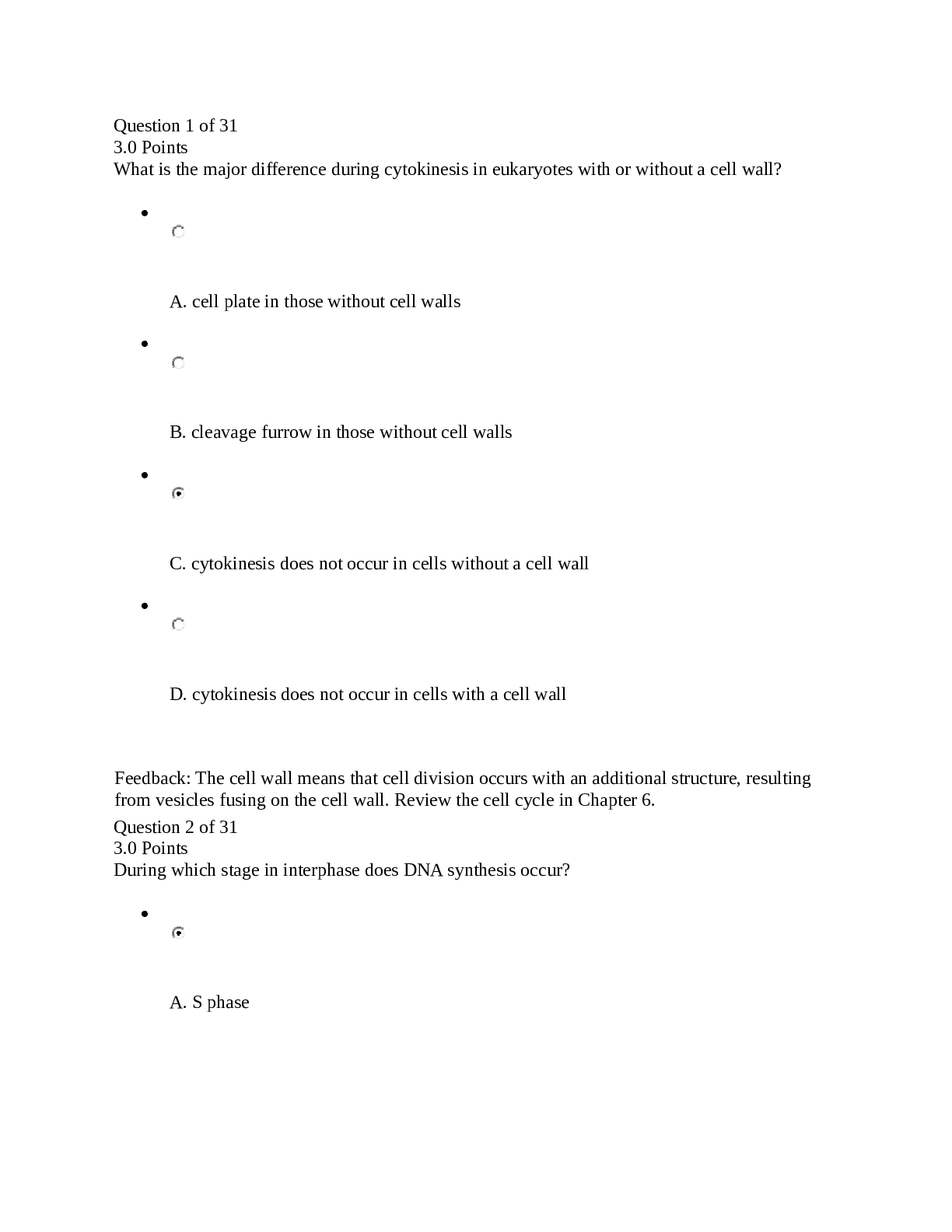
Buy this document to get the full access instantly
Instant Download Access after purchase
Buy NowInstant download
We Accept:

Reviews( 0 )
$9.00
Can't find what you want? Try our AI powered Search
Document information
Connected school, study & course
About the document
Uploaded On
May 02, 2022
Number of pages
22
Written in
Additional information
This document has been written for:
Uploaded
May 02, 2022
Downloads
0
Views
161





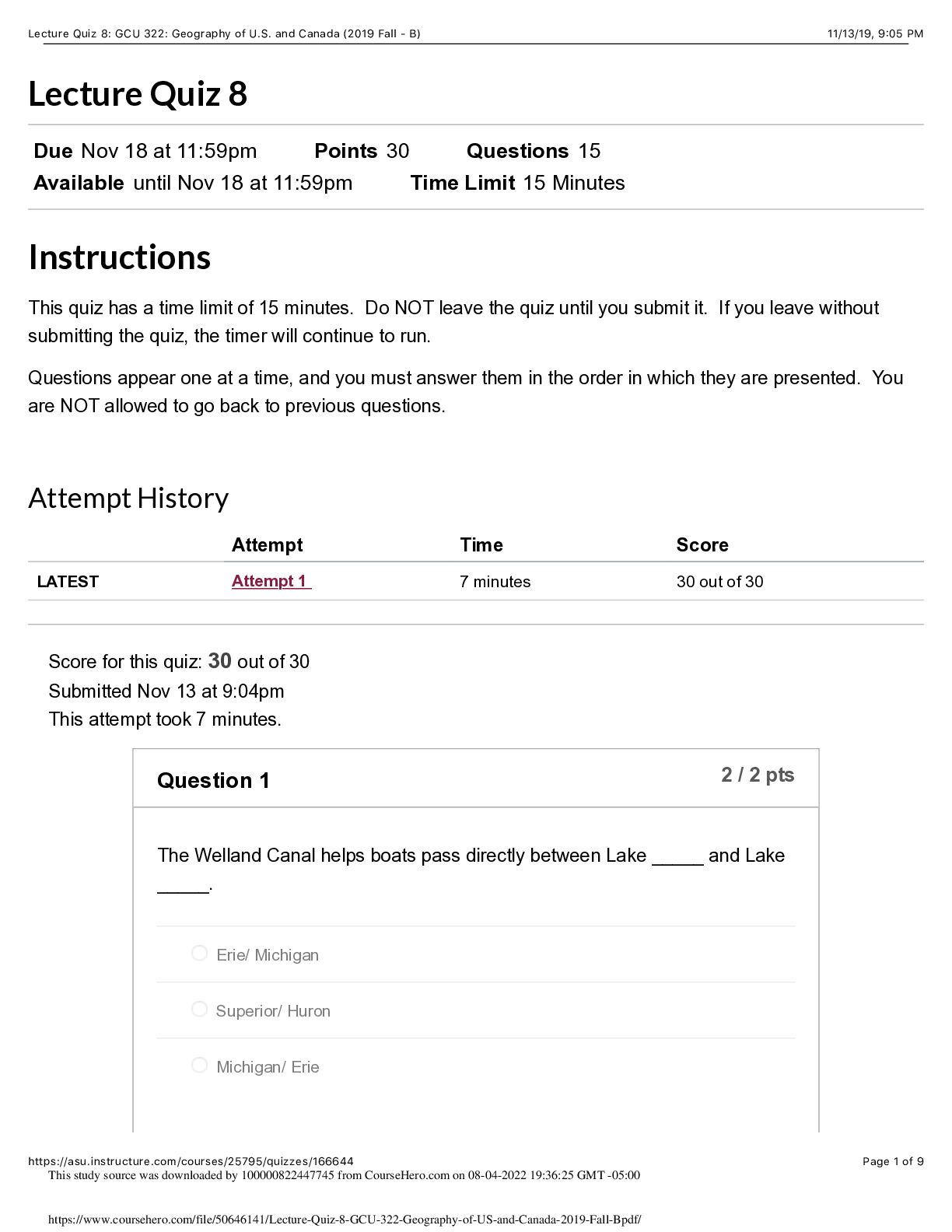
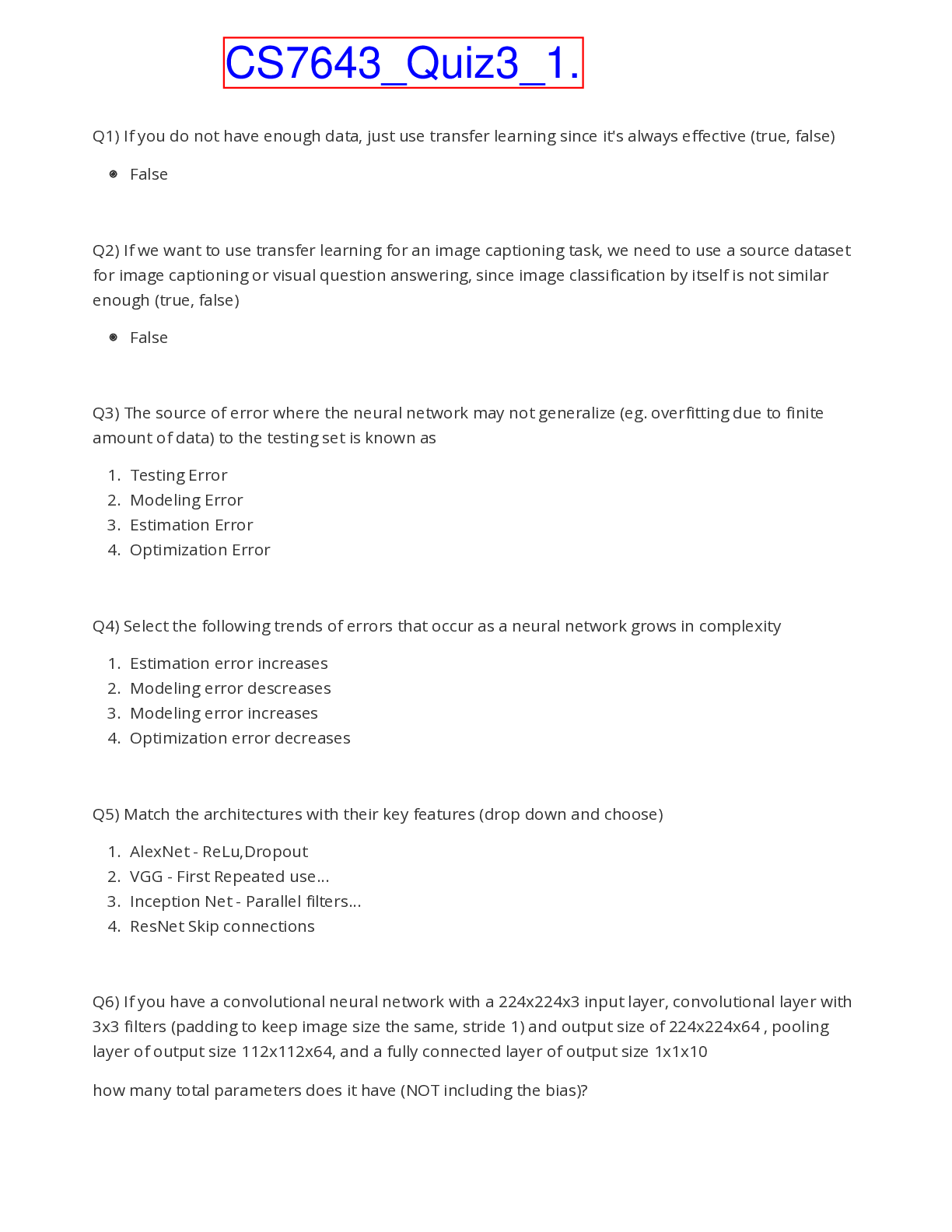
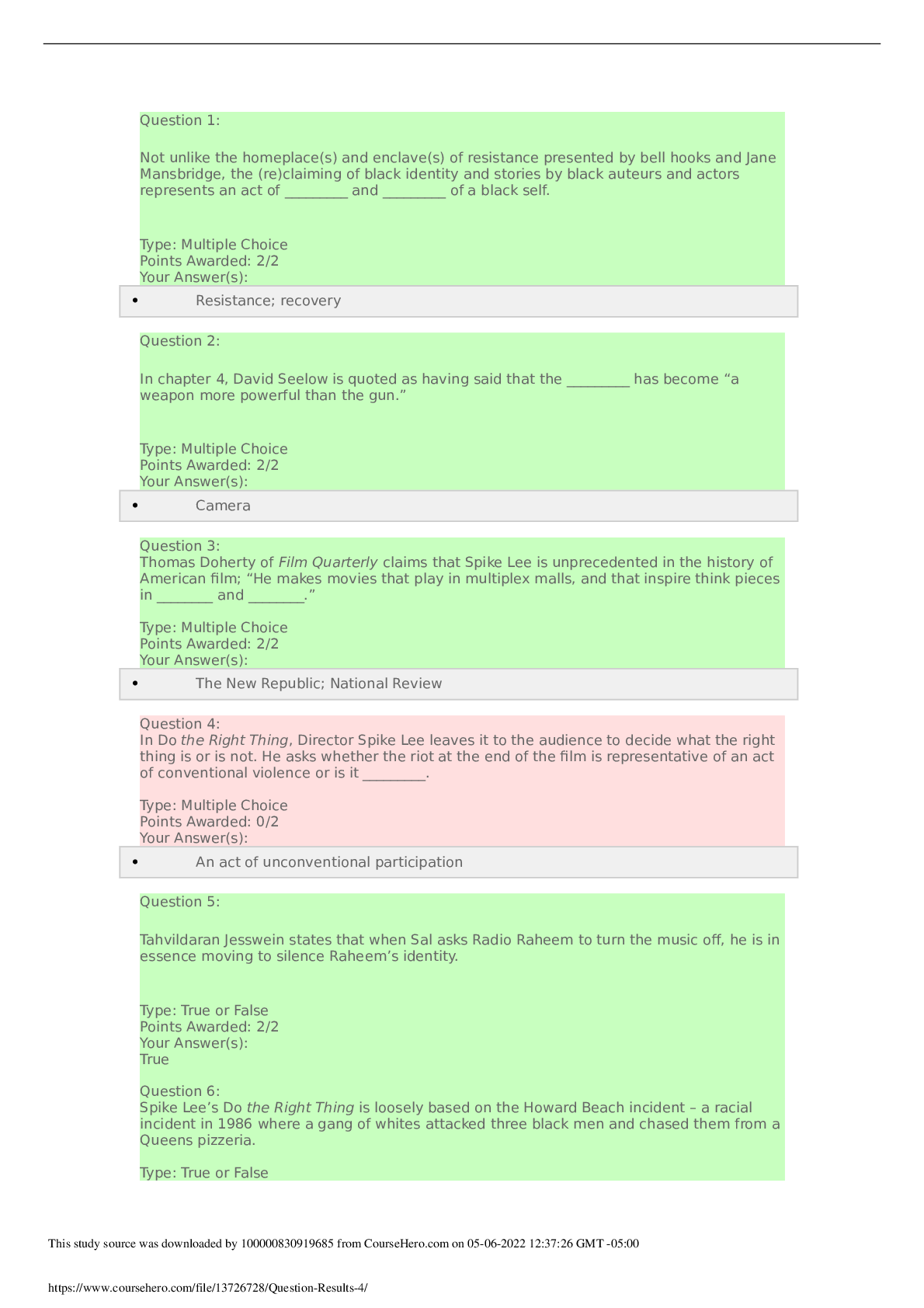
.png)
